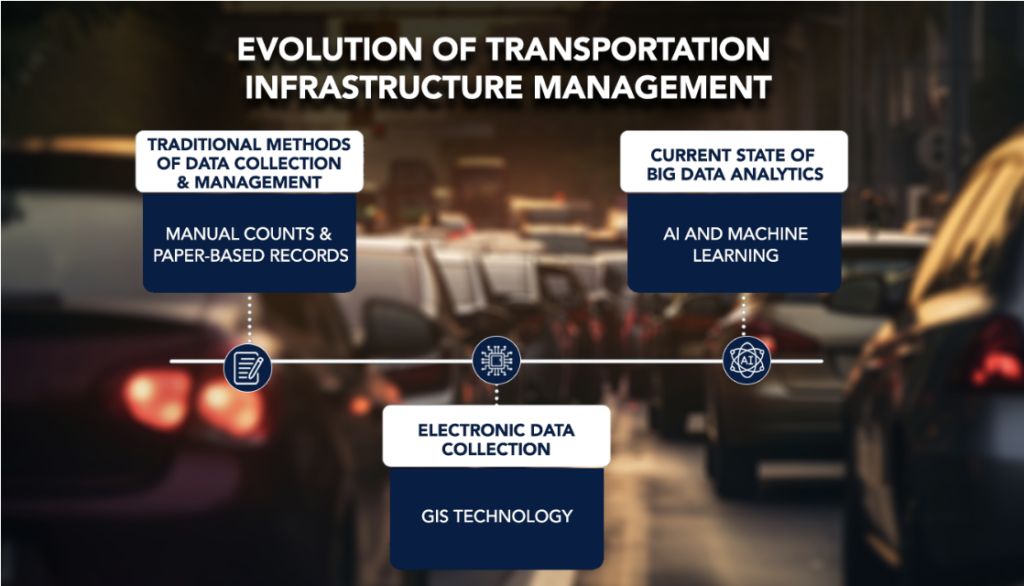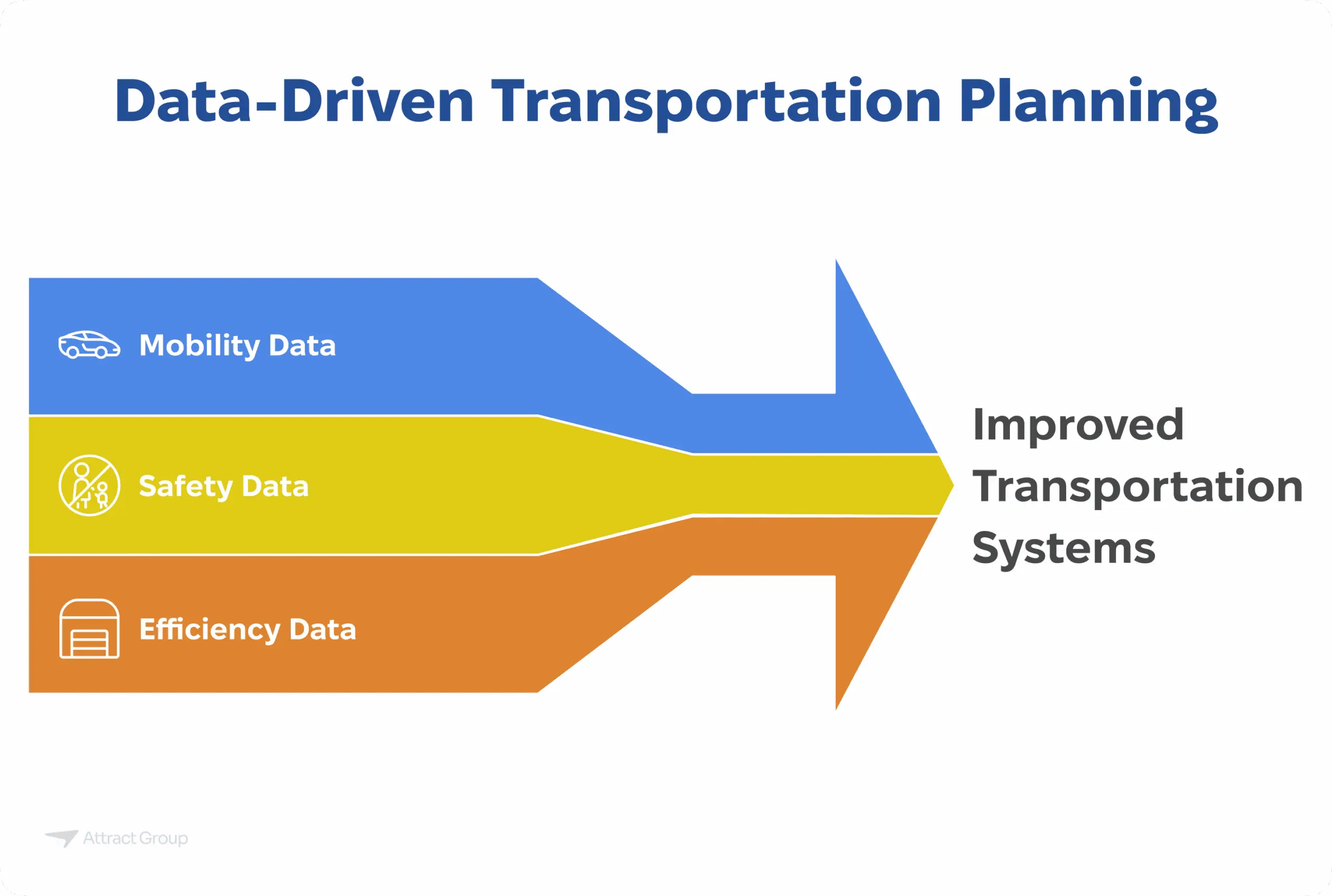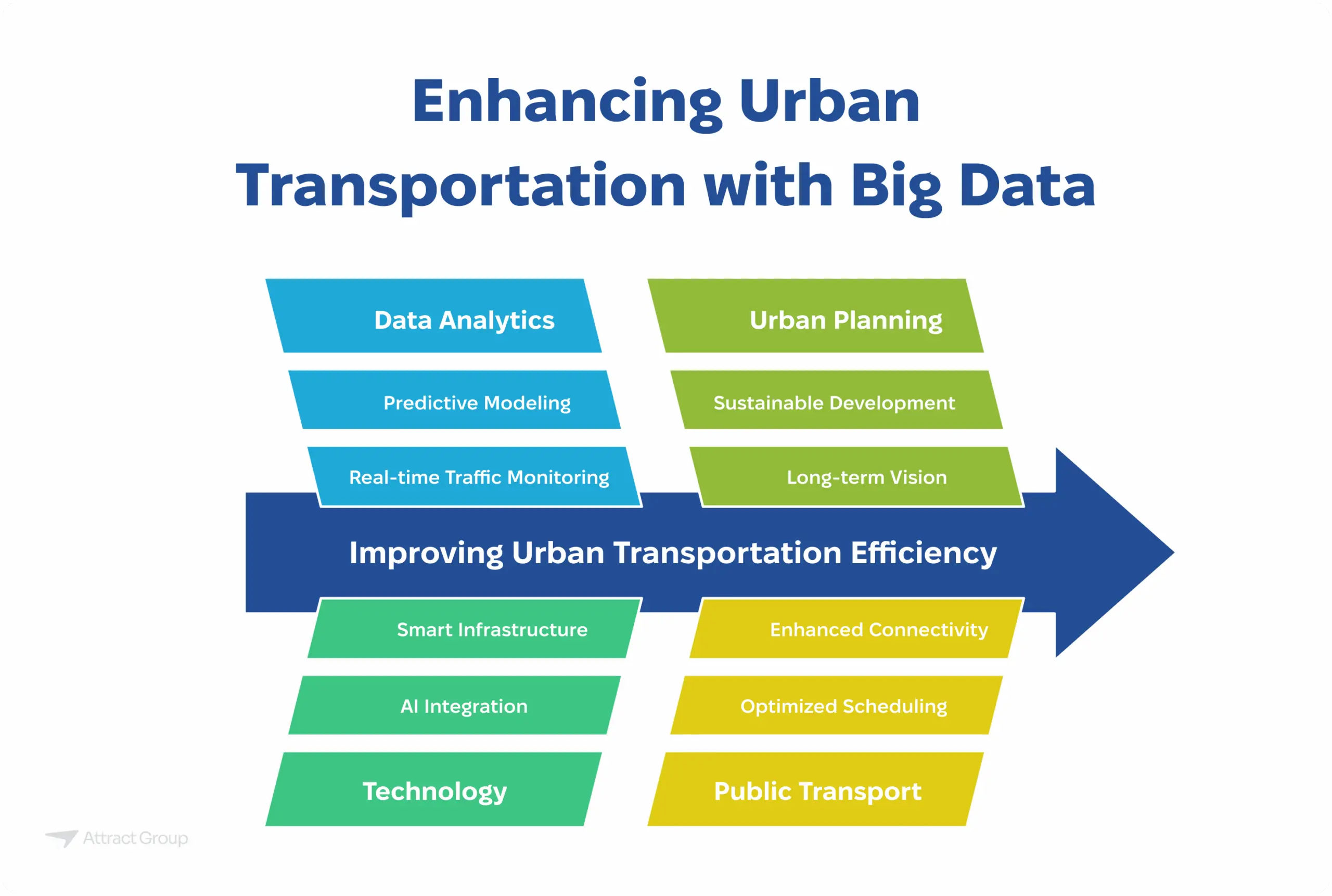How to Use Big Data Analytics in Transportation Planning
 10 May 2024
10 May 2024? Listen to the Summary of this article in Audio
Every day, urban transport creates over 500 petabytes of data. This number grows with smart city tech. This rich data, from commuters, vehicles, and infrastructure, boosts transportation planning. By using powerful algorithms, city planners make our urban lives better. They’re transforming how we move in our cities. Big data doesn’t just improve things now; it also shapes the future. It ensures urban transport gets better, making our cities great places to live.

Key Takeaways
- Big data analytics in transportation planning enables effective navigation through the complexities of urban mobility.
- Transportation optimization algorithms are vital for deciphering vast data streams and improving transit systems.
- Real-time traffic analytics contribute to the reduction of congestion and enhancement of city planning strategies.
- Smart city transportation analytics inform sustainable urban development and transport policy-making.
- Leveraging big data allows for proactive adjustments to transportation networks, accommodating dynamic urban demands.
Understanding Big Data Analytics
Big data analytics has changed many sectors, including transportation. This technology helps us understand and predict transportation systems. It makes managing transportation data easier. This leads to better planning based on data.
Key Components of Big Data Analytics
Big data analytics includes key components, each crucial for making sense of huge data sets. Data acquisition collects information from many sources, like traffic sensors. Then, this data is curated and stored safely. This step is vital for successful data management.
Analysis and processing come next, often using GIS technology. This allows us to see patterns and trends. With this insight, we can plan more strategically.
Exploring Data-Driven Evolution in Transportation Infrastructure Management
In the following insightful video, Arif Rafiq, the Transportation Industry Manager at Esri Canada, delves into the realm of data-driven evolution in transportation infrastructure management. He discusses the complexities and challenges faced by government transportation authorities, emphasizing the importance of collaboration and leveraging data for informed decision-making. Rafiq paints a vivid picture of how various departments within these authorities work autonomously yet can benefit immensely from shared insights and collaboration. Through technology, Rafiq and his team aim to facilitate this organizational shift towards a more data-driven approach, ultimately enhancing the efficiency and effectiveness of transportation systems management:
How Big Data Analytics Works: An Overview
Transportation experts use analytics tools such as R, Python, and MATLAB. These tools help analyze complex data effectively. They are essential for detailed statistical analysis and handling different types of data.

These tools help study travel patterns and how transit systems work. They also look into vehicular trends. This helps improve service frequency and routing decisions.
| Analytics Tool | Application in Transportation | Benefit |
|---|---|---|
| R | Spatial data analysis | Enhances route planning with accurate geographic insights |
| Python | Traffic pattern analysis | Allows for scalable and versatile analysis of traffic flow |
| MATLAB | Modeling and simulation | Enables predictive analytics for future planning |
With GIS technology, big data analytics is shaping the future of transportation planning. It allows for both reactive and proactive use of data. This leads to smarter transportation systems. It moves us towards better infrastructure management by focusing on prediction and optimization.
Our data analytics experts can help you leverage cutting-edge tools like R, Python, and MATLAB to gain valuable insights and drive intelligent planning.
Introduction to StreetLight: Transportation Analytics using Big Data
In this video on Smart City research, Nathan Shay, a Solutions Engineer at StreetLight, discusses the integration of big data into transportation planning and decision-making processes. Nathan showcases how StreetLight utilizes extensive data analysis to provide actionable insights for transportation planners and engineers, ultimately aiming to enhance efficiency, equity, and data-driven decision-making in the transportation industry. Through examples and demonstrations, Nathan illustrates the power of leveraging big data to understand evolving transportation patterns and address contemporary challenges such as pandemic-related shifts, ride-hailing trends, and micro-mobility impacts:
Practical Guide: Using Big Data Analytics in Transportation Planning
Cities must now use data-driven approaches to improve mobility, safety, and efficiency. Big data analytics offers tools to understand vast amounts of data from different sources. It helps make better decisions in transportation planning and optimization.
1. Identifying the Right Data for Transportation Planning
Choosing the correct data is key for effective mobility analytics. Planners should use data from mobile signals, GPS trackers, and public transit systems. This ensures they capture real traffic patterns and trends.
2. Integrating Big Data Analytics into Transportation Systems
Big data solutions make transportation systems better by creating a connected framework. This framework combines current and past data. It gives transportation authorities a complete view for planning.
3. Utilizing Predictive Analytics for Traffic and Route Management
Predictive modeling considers various factors, like weather and events, to avoid traffic problems. Using predictive analytics enables smoother traffic flow across all transport modes.

4. Leveraging Data for Enhanced Public Transportation Scheduling
Big data analytics improves public transportation scheduling. It helps match bus or train times to when people need them. This makes travel better for everyone while cutting costs.
5. Big Data Solutions for Freight and Logistics Management
Data analytics improves routes and schedules in freight and logistics. It reduces delivery times and increases efficiency. This is by preparing for possible disruptions and adapting to changes.
6. Real-time Data Analysis for Emergency Response and Safety Improvements
In emergencies, analyzing vehicle data quickly is crucial. Real-time data helps speed up emergency services and makes roads safer. It does this by monitoring and adjusting to traffic issues as they happen.
Real-World Applications of Big Data in Transportation
Today’s world is being reshaped by digital transformation, and transportation is in the mix. Intelligent transportation systems and machine learning for transportation data are changing how we move. They lead to smarter, more efficient ways to handle traffic and logistics.

Case Study: Smart City Traffic Management Systems
Smart cities use machine learning to analyze lots of traffic data. They create systems that manage traffic in real-time. These systems look at how many cars there are and when roads get busy.
This helps reduce traffic jams and makes commuting better for everyone. Cities also see less pollution and people spend less time traveling. Transportation infrastructure analytics play a big part in this progress.
Case Study: Predictive Analytics for Railroad Operations
Predictive analytics are a game-changer for railways. They make trains more timely and safe. By predicting needs, railways can plan better and avoid problems.
This smart use of machine learning for transportation data improves maintenance, incident handling, and how many trains can run. It’s all about being more efficient and safe.
Case Study: Data-Driven Airport Logistics and Scheduling
Big data is making air travel smoother. It helps with managing flights, passengers, and airport resources. This means flights are on time more often, resources are used well, and travelers are happier.
Innovations with GIS technology in transportation planning are also important. They help airports grow in smart ways.
These stories show how technology is making transportation better. Let’s look at how these technologies connect:
| Technology | Application | Impact |
|---|---|---|
| Machine Learning | Traffic Prediction | Reduced Congestion |
| GIS Mapping | Route Optimization | Enhanced Navigation |
| Data Analytics | Logistics Planning | Operational Efficiency |
| Predictive Analytics | Maintenance Scheduling | Increased Safety |
Technology’s role in transportation improves how systems work today and opens doors for new solutions. It meets the increasing demands of global movement.
Let our team build a custom big data analytics platform to optimize traffic flow, reduce congestion, and improve urban mobility.
How to Get Started with Big Data Analytics in Your Transportation Project
Starting a project in transportation with big data analytics is exciting and full of benefits. It needs a plan to use technology and methods to make transportation better. Knowing how big data can improve predictions in transportation is the first step to making a big difference in efficiency and being eco-friendly.

Assessing Your Data Needs and Capabilities
It’s crucial to understand what data your project needs. Figure out what data is important and how it matches your abilities. Look into the valuable data for your project, such as traffic trends, traveler habits, and supply chain info. Make sure you can gather and manage this data securely, following all privacy rules.
Selecting the Right Big Data Tools and Technologies
After knowing what data you need, pick the right big data tools. Choose tools that fit your goals, from algorithms for better transportation to data analysis software. Each tool should help in a specific way, like faster processing, deeper analysis, or easier use, for making informed choices.
Building a Skilled Team for Data Analysis
For big data to be useful, you need a skilled team. Gather people good at data analysis and familiar with tools like R, Python, or MATLAB. They should know a lot about transportation and how to use data insights in that context.
Establishing Partnerships for Data Sharing and Collaboration
Working together can make your data analysis better. Create partnerships to share data and get more insights. These partnerships should help you do a deeper analysis and make better plans for your transportation project.
By following these key strategies, companies can effectively use big data in their transportation projects. This prepares them for smart planning and improving their networks.
Conclusion: The Road Ahead for Big Data in Transportation Planning
We are at the brink of a major breakthrough in city design and connectivity. The use of big data analytics is key for advanced transportation infrastructure planning. As cities grow quickly, we face many new challenges.
Our solutions must be both creative and long-lasting. Data-driven planning has become essential in this effort. It builds a system where choices are guided by up-to-date data and forecasts.
Traffic analytics in urban planning have changed how cities handle traffic jams, schedule buses and trains, and keep up with road work. These methods do more than just react. They help plan our cities’ future movement with big data tools and new tech like AI.

This leads to much better public transport systems. And it makes the way we use different types of transport much smoother.
Looking ahead, smart city transport methods and sustainable transportation solutions seem within our grasp. The hard work of transport experts to use all big data can offer is clear. Their effort will take our cities into a new era of being efficient, strong, and green.
The path forward is all about getting better and coming up with new ideas. By focusing on data, cities will become smarter, safer, and ready for their growing number of people.
Our experts are ready to help you leverage big data analytics to create efficient, sustainable, and future-proof transportation systems.

Source Links
- https://www.linkedin.com/pulse/power-data-analytics-transportation-planning-syed-moosa-raza
- https://www.streetlightdata.com/what-transportation-big-data-analytics/
FAQs
What is the significance of big data analytics in transportation planning?
Big data analytics is vital in transportation planning. It optimizes urban transport and develops algorithms. Moreover, it offers real-time traffic data. It is the core of smart city transport analytics. This improves how we move, boosts efficiency, and increases safety in cities.
What are the key components of big data analytics?
Three key elements define big data analytics: data collection, processing, and interpretation. These elements help professionals understand and use large data volumes. This understanding aids in planning and making decisions.
How does big data analytics enhance urban transportation systems?
Big data analytics reveals travel habits. It aids in managing traffic and scheduling. It also allocates resources better. Additionally, it powers intelligent transport systems. It improves machine learning for transport data and uses GIS for planning.
How can transportation planners identify the right data for transport planning?
Planners find the right data by examining mobile data, vehicle systems, and transit usage. This helps predict demand and improve systems. Predictive models and mobility analytics then refine these data sets. These refinements aid in making strategic choices.
What role does predictive analytics play in traffic and route management?
Predictive analytics uses past and present data to predict traffic. It optimizes routes and eases congestion. This makes transportation more efficient and proactive.
How does big data contribute to public transportation scheduling?
Big data improves public transport schedules by studying passenger trends and peak times. It tailors service frequencies and routes to enrich passenger experiences.
In what ways does big data impact freight and logistics management?
In freight and logistics, big data boosts routing efficiency, cuts delivery times, and refines supply chains. It does this through real-time insights.
How does real-time data analysis benefit emergency response in transportation networks?
Real-time data analysis gives quick insights into traffic for emergencies. It keeps transport networks safe and helps improve safety measures continually.
Can you provide some real-world applications of big data in transportation?
Big data’s real-world uses include AI-based traffic systems to reduce congestion. It also involves predictive analytics for rail demand and improving airport logistics.
What steps should be taken to start with big data analytics in a transportation project?
To start, assess data needs and decide on the best big data technologies. Form a data-savvy team and create data partnerships for in-depth insights.
What future trends can we anticipate in the use of big data analytics for transportation planning?
Expect more AI and machine learning for predictive modeling. Focus will grow on sustainable transport and using traffic data for urban planning.










